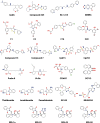Targeting Cullin-RING E3 ubiquitin ligases for drug discovery: structure, assembly and small-molecule modulation
- PMID: 25886174
- PMCID: PMC4403949
- DOI: 10.1042/BJ20141450
Targeting Cullin-RING E3 ubiquitin ligases for drug discovery: structure, assembly and small-molecule modulation
Abstract
In the last decade, the ubiquitin-proteasome system has emerged as a valid target for the development of novel therapeutics. E3 ubiquitin ligases are particularly attractive targets because they confer substrate specificity on the ubiquitin system. CRLs [Cullin-RING (really interesting new gene) E3 ubiquitin ligases] draw particular attention, being the largest family of E3s. The CRLs assemble into functional multisubunit complexes using a repertoire of substrate receptors, adaptors, Cullin scaffolds and RING-box proteins. Drug discovery targeting CRLs is growing in importance due to mounting evidence pointing to significant roles of these enzymes in diverse biological processes and human diseases, including cancer, where CRLs and their substrates often function as tumour suppressors or oncogenes. In the present review, we provide an account of the assembly and structure of CRL complexes, and outline the current state of the field in terms of available knowledge of small-molecule inhibitors and modulators of CRL activity. A comprehensive overview of the reported crystal structures of CRL subunits, components and full-size complexes, alone or with bound small molecules and substrate peptides, is included. This information is providing increasing opportunities to aid the rational structure-based design of chemical probes and potential small-molecule therapeutics targeting CRLs.
Figures












References
-
- Ciechanover A., Hershko A., Rose I. 2004. The Nobel Prize in Chemistry 2004, http://www.nobelprize.org/nobel_prizes/chemistry/laureates/2004/ - PMC - PubMed
Publication types
MeSH terms
Substances
Grants and funding
LinkOut - more resources
Full Text Sources
Other Literature Sources

